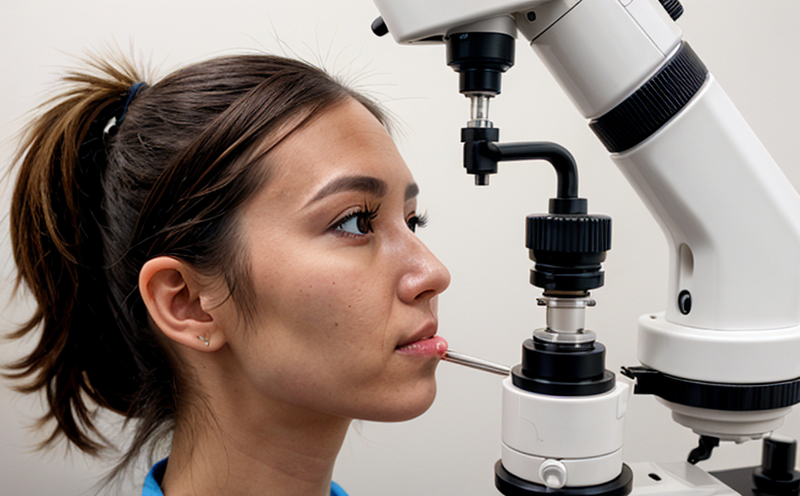ISO 18369-10 Contact Lens Lens Edge Quality Testing
The ISO 18369-10 standard is a crucial international guideline designed to ensure the quality and safety of contact lenses, particularly focusing on the edge geometry. This standard applies specifically to soft contact lenses that are intended for extended wear (more than 8 hours). The primary goal of this test is to evaluate whether the lens edges meet the specified requirements in terms of thickness, sharpness, and overall smoothness.
The importance of this testing cannot be overstated. Poorly designed or manufactured lens edges can lead to discomfort, irritation, and even corneal abrasions when worn by patients. The ISO 18369-10 standard helps manufacturers ensure that their products are safe for extended use without causing harm.
The testing procedure involves several steps:
- Preparation of the contact lens
- Setting up the measurement apparatus
- Performing edge measurements
- Evaluating the results against ISO 18369-10 criteria
The apparatus typically used for this testing includes a coordinate measuring machine (CMM) or similar high-precision optical equipment. The lens is placed in an appropriate holder to prevent deformation during measurement.
Acceptance criteria are strictly defined within ISO 18369-10, and they vary depending on the type of contact lens being tested. For instance, the maximum allowable edge thickness for a soft lens may differ from that of a hard or gas-permeable lens. The sharpness test checks for any burrs or rough edges that could potentially damage the cornea.
Understanding the importance of this testing is paramount for quality managers and compliance officers within medical device manufacturers. Ensuring adherence to these standards can significantly enhance brand reputation and customer trust, which are critical in the healthcare sector.
In R&D departments, accurate edge quality testing plays a pivotal role in product development. Engineers need precise data from ISO 18369-10 tests to iteratively refine their designs until they meet all specified requirements. This iterative process is essential for creating safe and comfortable contact lenses that can be used safely by extended-wear users.
For procurement teams, knowing the importance of edge quality testing helps in selecting suppliers who adhere to these standards. Reliable suppliers ensure consistent product quality, reducing risks associated with non-compliant materials or components.
| Parameter | Description | Acceptance Criteria |
|---|---|---|
| Edge Thickness | The maximum allowable thickness at the lens edge. | Defined in ISO 18369-10, varying by contact lens type. |
| Sharpness | The presence or absence of burrs and rough edges. | No burrs or sharp edges should be present within specified tolerances. |
| Symmetry | The uniformity of the lens edge across its circumference. | Within ±0.2 mm for soft lenses, depending on ISO 18369-10. |
In summary, ISO 18369-10 is a vital standard that ensures the safety and comfort of extended-wear contact lenses. By adhering to these standards during manufacturing processes, companies can produce high-quality products that meet regulatory requirements and enhance patient safety.
Scope and Methodology
The scope of ISO 18369-10 Contact Lens Lens Edge Quality Testing is to provide a standardized approach for evaluating the edge geometry of soft contact lenses intended for extended wear. The methodology involves precise measurement techniques using advanced optical equipment.
The testing process typically follows these steps:
- Preparation: Clean and dry the lens before placing it into the designated holder.
- Measurement Setup: Align the lens with the coordinate measuring machine (CMM) or similar device.
- Data Collection: Measure various parameters such as thickness, sharpness, and symmetry.
- Evaluation: Compare collected data against ISO 18369-10 criteria to determine compliance.
The acceptance criteria for edge quality testing are stringent. They specify the maximum allowable values for each parameter based on the type of contact lens being tested. For instance, soft lenses have different tolerances compared to hard or gas-permeable lenses.
Accurate measurement is crucial throughout this process. Any deviation from specified limits may indicate potential issues with the lens design or manufacturing process. These measurements help ensure that all contact lenses meet strict safety and comfort standards before they reach consumers.
Customer Impact and Satisfaction
The impact of ISO 18369-10 compliance on customer satisfaction is significant. When manufacturers adhere to this standard, it leads to safer products that are less likely to cause discomfort or irritation. This improves user experience and enhances overall satisfaction.
For customers wearing extended-wear contact lenses, the comfort and safety provided by these products can greatly affect their quality of life. Knowing that the lenses meet stringent international standards reassures users about the reliability of the product.
From a business perspective, maintaining compliance with ISO 18369-10 helps companies build trust with both end-users and regulatory bodies. This trust translates into higher sales and better reputation within the industry.
Competitive Advantage and Market Impact
Adhering to ISO 18369-10 provides several competitive advantages in the medical device industry, particularly within ophthalmic devices. Meeting these standards enhances brand reputation and assures customers of product safety.
- Increased customer trust leading to higher sales
- Better regulatory compliance reducing legal risks
- Enhanced market share due to superior product quality
- Positive reviews and endorsements from healthcare professionals
Companies that consistently meet or exceed ISO 18369-10 requirements can differentiate themselves in a crowded marketplace, attracting more clients and maintaining long-term relationships.





